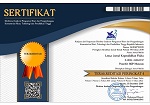EFEKTIFITAS PROGRAM APLIKASIPhET SIMULATIONS DALAM MENINGKATKAN AKTIVITAS DAN HASIL BELAJAR SISWA PADA MATERI LISTRIK DINAMIS DI KELAS IX.1 SMPN 2 LINGSAR
DOI:
https://doi.org/10.33394/j-lkf.v3i2.381Keywords:
PhET application program, Activity and student learning outcomes.Abstract
Based on the observations and interviews of some physics teachers, it was found that the teacher felt that he had tried to improve the learning techniques in the classroom. But the activity and achievement of student learning not yet according to expected result. The learning pattern applied is teacher-center learning. Therefore, this is very inconsistent with the characteristics of science learning. PhET (Physics Education Technology) application program is one of the learning tools that requires students to take an active role during the learning process. This study is a classroom action research conducted in two cycles to determine the effectiveness of learning. Each cycle takes place in two sessions. Each cycle consists of the stages of planning, implementation of action, observation, evaluation, and reflection. The subject of the research is the students of class IX.1 SMPN 2 Lingsar. The results of the evaluation of cycles I and II showed a significant increase. The average score of student learning activity increased from 7.95 to 11.39 (medium to high category) and the average student evaluation score increased from 62.5 to 76.65. We concluded that the PhET application program is effective for increasing activity and student learning outcomes.
References
Alwi, H, dkk. 2002. Kamus Besar Bahasa Indonesia Edisi ketiga. Jakarta: Balai Pustaka.
Aqib, Z. 2006. Penelitian Tindakan Kelas bagi Pengembangan Profesi Guru. Bandung : Yrama Widya
Else Neny. 2008. (http://www.psb-psma.org/content/blog/phet-solusi-terbaik-untuk-lab-virtual-2008/10/31, diakses tanggal 1 September 2011)
Niff.MC. 1992. Action Research Principles and Practise. Bandung: Mizan Media Utama.
Nurkancana Wayan, Sunartana PPN. 1990. Evaluasi Hasil Belajar. Surabaya : Usaha Nasional.
Purnama Wahyu.2002. (Tecnology Information & Communication (TIK/ICT) (http : //wahyupur.blogspot.com 2010/06/02, diakses tanggal 1 September 2011)
Ridwan. 2008. Ketercapaian Prestasi Belajar. (http://ridwan202,wordpress.com/2008/05/03/ketercapaian-prestasi-belajar/,diakses tanggal 1 September 2011)
Suharsimi, A. 2002. Dasar-dasarEvaluasi Pendidikan. Jakarta: Bumi Aksara.
Shumsky. 1982. Classroom Research. Bandung : Mizan Media Utama.
Downloads
Published
How to Cite
Issue
Section
License
Authors who publish with Lensa: Jurnal Kependidikan Fisika agree to the following terms:
- For all articles published in Lensa: Jurnal Kependidikan Fisika, copyright is retained by the authors. Authors give permission to the publisher to announce the work with conditions. When the manuscript is accepted for publication, the authors agree to automatic transfer of the publishing right to the publisher.
- Authors retain copyright and grant the journal right of first publication with the work simultaneously licensed under a Creative Commons Attribution-ShareAlike 4.0 International License that allows others to share the work with an acknowledgment of the work's authorship and initial publication in this journal.
- Authors are able to enter into separate, additional contractual arrangements for the non-exclusive distribution of the journal's published version of the work (e.g., post it to an institutional repository or publish it in a book), with an acknowledgment of its initial publication in this journal.
- Authors are permitted and encouraged to post their work online (e.g., in institutional repositories or on their website) prior to and during the submission process, as it can lead to productive exchanges, as well as earlier and greater citation of published work (See The Effect of Open Access).

This work is licensed under a Creative Commons Attribution-ShareAlike 4.0 International License.



